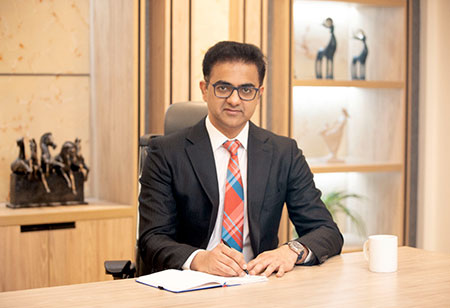Dr. Aashish Chaudhry, MD & Senior Consultant & Head, Department of Orthopaedics & Joint Replacement, Aakash Healthcare

Dr. Aashish Chaudhry is an esteemed healthcare professional with over 20 years of experience in the medical realm. His leadership has transformed healthcare, marked by pioneering ventures and global expansions. His expertise spans orthopedic surgery, including advanced robotic knee replacements and MIS hip surgeries. A distinguished graduate of Maulana Azad Medical College, with a postgraduate degree from Lady Hardinge Medical College, he also holds certifications from the Royal College of Surgeons, Glasgow, and a Healthcare Management degree from the Indian School of Business.
Artificial intelligence (AI) is quickly gaining momentum and permeating every aspect of our daily lives. The medical sector and the field of orthopaedics, in particular, is not far behind, given that substantial strides are being made towards integrating AI into different medical procedures.
The field of artificial intelligence in orthopaedics has recently received a lot of attention, and it is radically changing the way surgeons practice. Machine learning, a subset of AI can substantially enhance patient outcomes by providing researchers with a means to extract knowledge from data in a collection of observations on patients suffering from diverse injuries. The use of machine learning in conjunction with traditional surgical abilities not only saves money but also allows doctors to better serve their patients besides making the healthcare environment more sustainable. Furthermore, it enables a computer to construct rules and compliance procedures upon which to base its choices without being expressly coded. It is a highly useful tool for doctors who are dealing with a high volume of patients since it can analyze data and make conclusions about the patient and their treatment.
How AI is helping doctors?
Artificial intelligence (AI) systems are becoming increasingly important in medicine and orthopaedic surgery as a result of the virtually exponential rise in computer processing power, cloud computing, and the invention and refinement of medical-task-specific software algorithms. Because of the extensive role of technologies such as medical imaging in the management of orthopaedic disorders, which provide high sensitivity, specificity, and positive/negative prognostic value, the field is especially ripe for the application of machine-based integration of imaging studies, among other applications.
The use of AI in orthopedics continues to demonstrate its efficacy and the benefits it provides to patients and professionals. AI continues to push the boundaries of orthopedic practice, from extremely precise imaging to precise surgical planning. Patients with musculoskeletal injuries, such as shoulder and knee injuries, can benefit from artificial intelligence and machine learning. These issues are particularly common in people suffering from arthritis as well as athletes who are in active training. Doctors can focus more on the patient by using machine learning algorithms and computers to conduct repetitive tasks, which ultimately makes the health care system more effective and less expensive.
Improving patient care
AI has shown to be one of the most rapidly changing technologies, with new inventions always on the roll to improve its application. AI is not only making physicians' jobs easier, but it is also increasing their productivity. Patients, for their part, are bound to expect faster recovery times and a more targeted approach to their unique problems.
AI in orthopedics is greatly improving patient imaging with more precision and attention to detail. This significantly improves patient care, given that the radiologist can identify the patient’s problems and come up with a treatment plan. AI goes a step further by including more complex 3D visuals that provide a complete picture and context for the task at hand. The use of AI in the imaging process will help detect fractures and other conditions like osteoarthritis faster. This significantly decreases the evaluation curve, allowing clinicians to provide patients with reliable answers.
Furthermore, AI technology makes use of a variety of tools that are ideal for patient-specific orthopedic surgery. To gain a better grasp of their patient's diagnosis, surgeons can use methods like automatic bone segmentation and landmark detection. This goes a long way toward assisting the surgeon to prepare beforehand by working with equipment to improve their efficiency.
Furthermore, AI technology includes a variety of recovery solutions that might assist patients in managing their illness. In the case of leg and foot pain, for example, it is recommended that the elderly wear compression socks. Tools that aid in the patient's recuperation increase the significance of AI in orthopedics.
Data interpretation is another area where AI comes in handy ensuring any data interpretation is automated. Interpretation of data could easily lead to fatigue and less attention to detail. With the use of AI, technology can easily and efficiently sift through different sets of data provided and come up with insights pertinent to a patient’s diagnosis. Not only does this reduce fatigue among healthcare professionals, but also substantially reduces the time required for data interpretation.
The use of AI also allows surgeons to work with orthopedic digital templating, a process useful in determining the appropriate implants to utilize and the measurements needed to get the desired results. Surgeons benefit from a comprehensive 3D visualization of the bones and the surgical site facilitating a smoother operative process as everything was planned. This pre-surgical planning has been shown to not only save time but also increase surgeon efficiency significantly.
Last but not least, AI now guides orthopedic surgeons in real time to help avoid any mistakes while allowing them to get their precision right and offer patients the best quality treatment, thereby, greatly improving the patient’s overall experience.